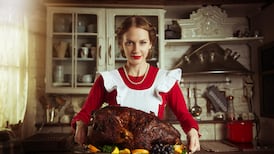One of the pleasures of being a blow-in cook is the opportunity to explore a whole new world of ingredients. What probably seems boring and commonplace to someone raised in Ireland might well be an exotic treat to me.
Take cabbage, for example. Other than, say, potatoes or bacon, is there a more common Irish ingredient? It’s something most cooks probably rarely give a second thought to.
But the first time I went to the market here and saw Savoy cabbage, it was a thrill. It might be the most beautiful vegetable around, with its deep Elizabethan ruff and vibrant colour, shading from dark green to buttery yellow. Yet in 40 years of cooking in the US, I don’t think I’d seen it more than a couple of times other than in paintings and photographs.
And pointy cabbages such as tenderheart, sugarloaf or sweetheart? They might as well have come from another planet.
READ MORE
So this winter, I decided to go to cabbage school. It was not a project I undertook lightly. A couple of years ago I wrote a column in these pages doing a similar thing with potatoes – cooking the different varieties in different ways to try to understand which was best for which type of dish.
Several weeks later I was in the checkout line at my local garden store when I noticed an older woman fixing me a beady stare. She looked like the ghost of Peig Sayers returned to scold. “Ah, so ye’re the man what’s supposed to be teaching us about potatoes, are ye?” she asked.
This time, I knew I needed to get the locals on my side, so I asked two of the best Irish cooks I know to help me sort out my cabbages. Michael Quinn, who runs the South East Technical University’s excellent culinary programme in Waterford, volunteered his splendid teaching kitchens and some of his students to help. Peter Everett, the Bib Gourmand-winning chef at Waterford’s Everett’s restaurant, loaned his palate and brought along one of his featured cabbage dishes.
Savoy was tough and chewy as old rubber bands when raw and took more than twice as long to soften in cooking as the others
We focused on five different varieties – white, red, pointy, Savoy and Nappa, or Chinese. We tasted them raw and then simply cooked (just a little water over high heat to soften – and a bit of butter and a sprinkling of salt because, after all, we’re not savages).
The results were fascinating. The cabbages we sampled varied tremendously in texture and flavour.
That beautiful Savoy, for example, was tough and chewy as old rubber bands when raw and took more than twice as long to soften in cooking as the others. But when it did, the flavour was much richer and more complex. It may be just my imagination, but despite using the same amount of butter for each sample, Savoy seemed to show off the flavour better.
The pointy cabbage, on the other hand, was more tender when raw and cooked much more quickly – in about half the time as Savoy. The flavour was much different, too, particularly after cooking – sweeter but also slightly saline. The texture was much more tender than the Savoy and almost slippery. One taster said it reminded him a bit of seaweed, in a good way.
Red round cabbage was crisp and sweet when raw with a hint of an almost pepper-like heat. Cooked, it was still a bit crunchy but the flavour was pretty simple. And the bright red colour had faded to a muddy purple. White “bowling ball” cabbage was crunchy but pretty bland both before and after cooking.
Nappa cabbage (sometimes misspelled “Napa” – the name has nothing to do with the California wine country, it’s the Japanese word for leafy greens) is delicate and slightly sweet raw. It cooks in a flash and has a bit of a vegetal flavour with a hint of something almost like courgettes.
As with my controversial potato experiment, this wasn’t a matter of choosing which variety was best, but rather thinking about which varieties would be better suited for what kinds of dishes.
Savoy, for example, would be perfect for any long-cooked dish, such as the one Peter Everett brought. In rough outline, he quartered the head and seared it over high heat. Then he braised it until it was nearly collapsing, before finishing it with the reduced braising liquid, some brown butter and chestnuts. It was rich and meaty enough to use as a vegetarian entrée.
[ Real Irish food for St Patrick’s Day: Eight recipes to celebrate our national dayOpens in new window ]
The white round cabbage is probably best used where its particular crunch is desired, in a slaw, or salted and fermented into a pickle-like sauerkraut. The red round cooks better, but it should have a little acidity added, both for flavour and to keep the colour bright.
I like to make a light slaw with Nappa cabbage. Cut it in slivers and mix it with green onion, then dress it with just a bit of rice vinegar, a splash of sesame oil and a sprinkling of sesame seeds. Any mayonnaise would be too heavy.
The pointy cabbage, with its hints of the sea, spurred the most talk, with Everett and Michael Quinn excitedly riffing ideas pairing it with seafood, such as using it as a base for a rich fish like monkfish or John Dory.
Sometimes it’s thinking like a blow-in that helps you fully appreciate what you’ve had all along.

















